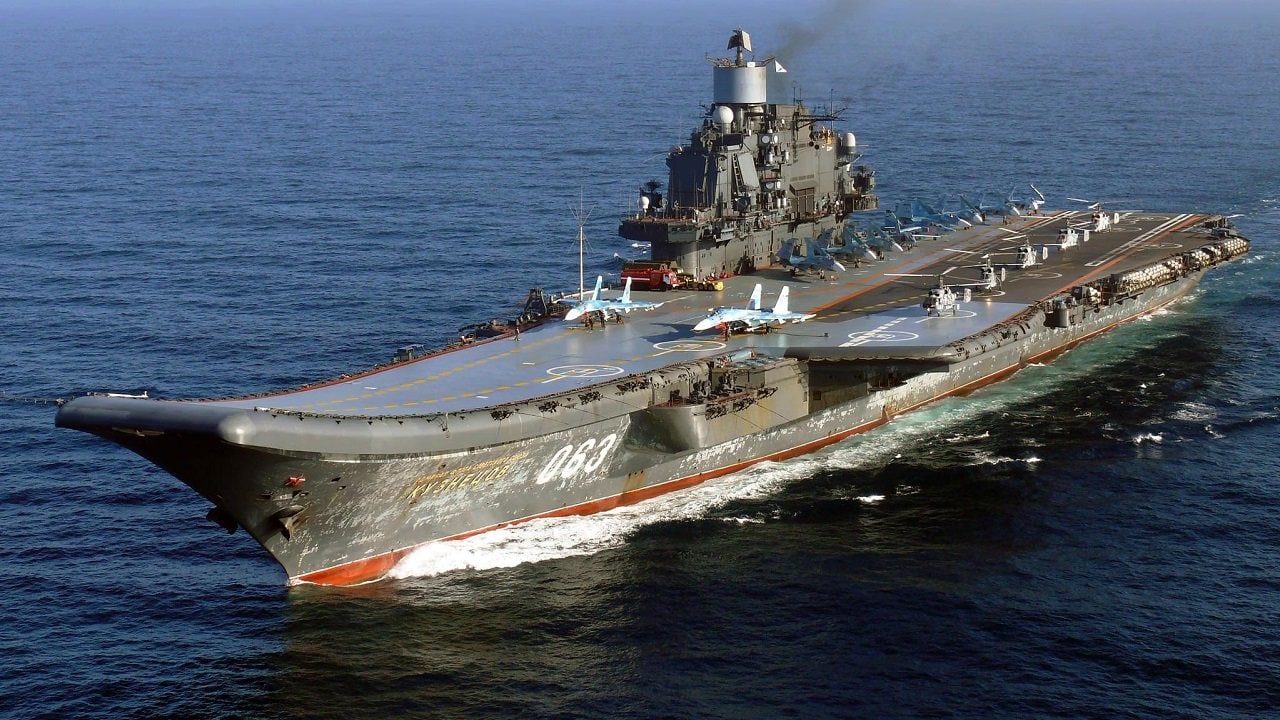The Battles of Coral Sea and Midway in the spring and summer of 1942 were both pivotal battles in the Pacific Theater of the Second World War and also proved the supremacy of the aircraft carrier over the battleship in naval tactics and strategy. In the following decades, carriers were continuously modified and upgraded, peaking with the nuclear powered supercarriers of today. Currently, 10 countries operate carriers of note, capable of launching and recovering fixed wing aircraft. While Russia technically makes this list, its sole carrier, the Admiral Kuznetsov is in poor shape.
Admiral Kuznetsov Design
The Admiral Flota Sovetskogo Soyuza Kuznetsov is the first of her class and Russia’s only carrier. Unlike U.S. supercarriers which use a steam catapult and a flat deck to accelerate aircraft for takeoff, the Kuznetsov uses a “ski-jump” design like that found on British and French carriers. This unique feature, which gives these ships a distinctive look with their upturned bows, allows aircraft to takeoff at slower speeds and does away with the necessity for complex catapult machinery.
Notably, the Kuznetsov is also designed to serve a different role in the Russian Navy than the carriers of the U.S. Navy. American Carrier Strike Groups primary role is power projection and deterrence – they enable policy makers to basically park an entire air force on any country’s doorstep at short notice. By contrast, the Kuznetsov is designed to complement Russian surface and submarine assets. Its complement of Su-33 aircraft serve primarily in an air superiority/fleet defense role, protecting missile submarines and surface combatants as they engage hostile fleets.
One of many design flaws plaguing the Kuznetsov is its use of Mazut fuel-oil to power its engine. This substance is a low quality fuel mostly prevalent in former Soviet countries. Western nations refine Mazut into diesel, a cleaner burning, more efficient product. Modern ships use either nuclear power or gas turbine engines which are far superior. One of the major drawbacks of using Mazut is the thick, oily, black smoke it produces. While modern satellite coverage makes hiding large ships quite difficult, when your ship produces a trail of smoke visible to the naked eye in space, it makes finding it that much easier.
A Brief History
After three years of construction, the Kuznetsov was launched in 1985 however it took 10 more years before she became fully operational. Initially she was expected to be part of the Black Sea Fleet operating out of Sevastopol in Crimea however with Ukrainian independence in 1991, she was urgently moved to the naval base in Vidyayevo, Murmansk as part of the Northern Fleet before the newly formed Ukrainian government could claim her.
As part of the Northern Fleet, the Kuznetsov participated in several Mediterranean deployments, culminating with a 2016-17 operation in which aircraft flying off the carrier struck targets throughout Syria. Nearly since its commissioning, the Kuznetsov has been plagued by problems which have recently seemed to accelerate. Although she was planned to remain in service until at least 2030, even her last deployment to the Mediterranean showed some signs of strain.
The task force set out with an escort of two ocean going tugs in case the propulsion system of the ship failed. An embarked Mig-29 crashed off the coast of Crete when it ran out of fuel while waiting on the crew to repair the broken arresting gear. Following this deployment, the ship was dry docked to effect a major refit, almost none of which has gone to plan. The first major incident occurred in 2018, when the floating drydock supporting the Kuznetsov sank, killing one and injuring four. It also caused a large construction crane to fall on the ship, opening a 200 square foot hole in the flight deck.
Once the wreckage from this incident was cleared, the carrier was towed to the Murmansk ship fitting facility. There were no drydocks large enough to accommodate her however, causing a delay as the shipyard had to merge two docks together. While waiting for the completion of the drydock, a major fire broke out on the Kuznetsov, killing four and injuring over a dozen. This repair bill was estimated at $8 million. Finally, after three years of work, the carrier was refloated in early 2023, not before another fire broke out on board, this one fortunately without loss of life.
Currently, Russian news reports the shipyard expects to begin sea trials in early 2024 and hand the ship over by the end of the year. With all the mishaps and issues, it seems unlikely that the Admiral Kuznetsov will sail any time soon.
Maya Carlin, a Senior Editor for 19FortyFive, is an analyst with the Center for Security Policy and a former Anna Sobol Levy Fellow at IDC Herzliya in Israel. She has by-lines in many publications, including The National Interest, Jerusalem Post, and Times of Israel. You can follow her on Twitter: @MayaCarlin.

